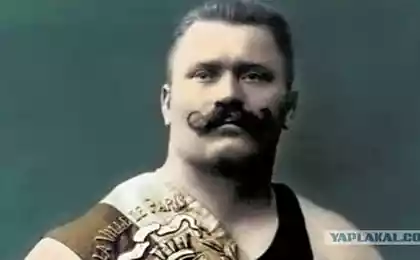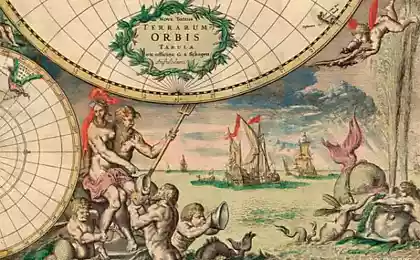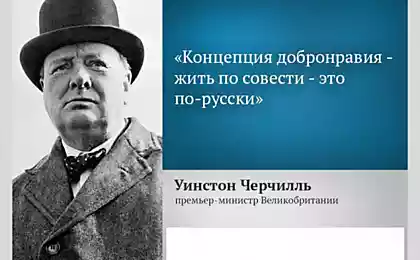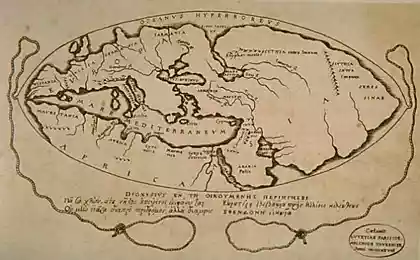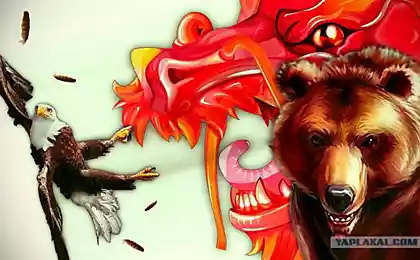3231
"Russian bear"
Why visual marker for centuries Russia was a bear? Not eagle, which is depicted in the Russian coat of arms, not faithful dog and even moose, which is so rich Russian forest.
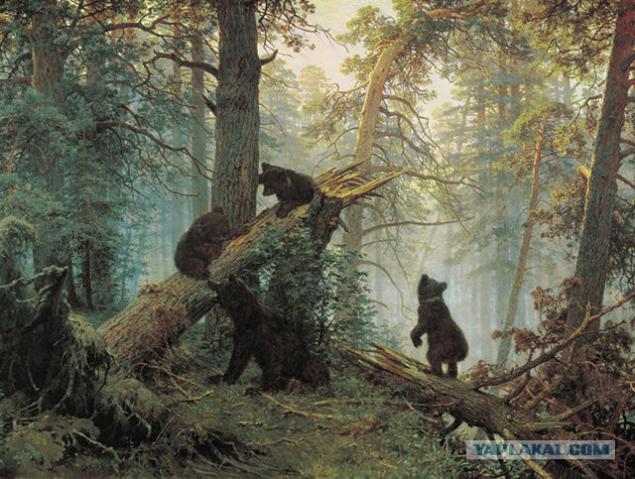
1. Itineraries
Any self-respecting European traveler in his notes about Russia certainly bears mention. Some told funny stories involving bears, others have described the spectacular carriages and sleighs, decorated with plush bear skins. English poet John Terbervill, guests in Moscow in 1568-1569 years, wrote that as a sign of the special guest of honor instead of a bed are invited to relax on a bearskin rug, pillow thus replaced the saddle. "In Russia, there is no other cover" - so confidently proclaimed Englishman.
Not ignored and major pop culture Russia - bear fun. According to the notorious Russian roads traveled gang with manual bears able to dance, tumble and even beg. So Dzhils Fletcher, a British poet, diplomat and a traveler who has seen a lot in my time, but never saw idly wandering around the capital of semi-wild animals. In his memoirs he wrote: "Wild bears usually catch pits or Tenet, kept in cages. On the appointed day and hour is going to court and countless people before featrom where the fight must go; There is a brave warrior with spear, and let the bear, who, seeing him, rears, tears and pursue it with the hole throat. Hunter motionless, looking marks - and a strong sweep spear thrusts into the beast, and the other end to the ground prignetaet her foot. Stung, furious bear crawls forward on iron, it irrigates his own blood and foam, aching, gnawing the shaft, and if not overcome, then fell on its side, with the last dull roar of the dying. People, hitherto silent, announces area with loud cheers of lively fun and hero lead to the cellar to drink for the king's sovereign health ... »
According to other witnesses, in Moscow Ivan the Terrible 100 people accounted for about one Bruins. Nobles and wealthy merchants, usually held in their wards and Terem least one bear "for the soul." Going into any crowded tavern of the time, you're sure to see clumsy. And, sometimes sitting with loud now and varnish brandy.
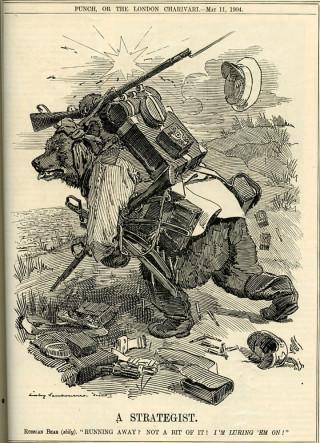
2. Muscovite monster
Not surprisingly, Russian bears were exported to European countries, primarily from Russia, becoming a real brand. For example, in 1749 the newspaper "Cambridge Chronicle" published advertisements inviting Europeans to see for baiting "the great Muscovite bear." In the company of each nomadic circus certainly was a bear, and even if he was caught not the Russian expanses, the viewer constantly repeated that this bloodthirsty monster and Shaggy - the most that neither is true "Muscovite" bear. Europeans, by the way, actively speculation that the clowns with the bears, who divorced a great many spies Grand Prince of Moscow.
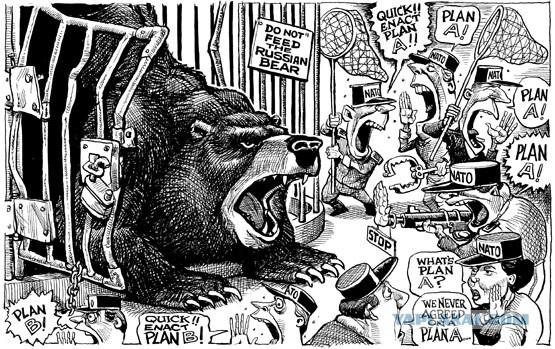
3. Knock-knock, open
Love the bears in Russia is reflected in Western cartoons. First allegorical image of our country in the form of a bear appeared in a manuscript in 1507, which most likely belonged to a certain John of Głogów. In the image of Europe-dragon confronts a bear-Asia, the latter body is central Muscovy.
In 1526, the Austrian diplomat Sigismund Herberstein in his description of the fierce Russian winter and the prevailing famine created the image bears, bursting in peasant houses. This picture is so liking to foreigners that it formed the basis of numerous anecdotes. Isolated cases of occurrence of wild bears in the winter in Russian villages and small towns were perceived as a regular event, which is quite common for the whole country. Not the last role is played and the way skoromoha manual bear. So over time, the description of one particular case has become a stereotype of wandering through Red Square bears.

4. The longitude, latitude and Clumsy
There was a bear, and the first map of Muscovy, which was made in 1544 by Senator Anthony Gdansk views. Clubfoot vignette depicted on this map. He is also involved in the scene where his gang try to tie good fellow. On the map of the British Ambassador Anthony Jenkinson bears and does quietly roam the territory of Muscovy. Later maps appear downright menacing number of bears walking around Russia, as well as illustrations of dashing Toptyg dancing Russian guys in the company.

5. Ancient roots
Admittedly, the Russian supply totem just came from our side. As you know, first began to compare himself with the bears Varangian guards in early Kievan Rus. Our pagan ancestors, according to historians, the bear perceived not only as a divine animal, but as a relative, referring to him as "the grandfather", "the old man", "lord." Another example - in the mythology of the Slavs heroes Rip Oak Mountain and Vale were nourished by a wolf and Bear. Last given them, by the way, strength and intelligence.
Even in the Christian period, despite the shift to a more negative evaluations - rage, laziness, aggression - the bear remains a revered animal. His images appear in masks and costumes masquerade, a bear is present in handicrafts, literature, fairy tales, is mentioned in proverbs and sayings.
All. Source: russian7.ru/2014/05/kak-poyavilsya-russkij-medved/
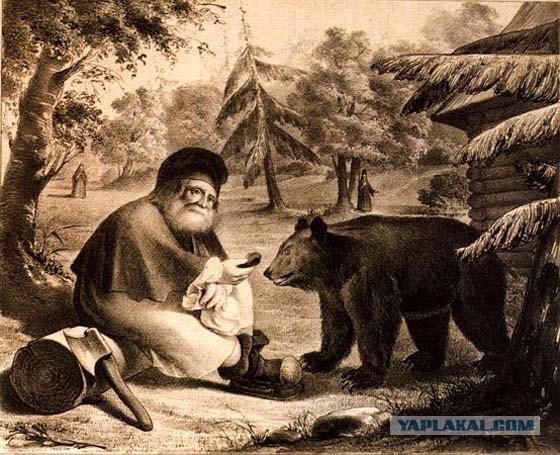

1. Itineraries
Any self-respecting European traveler in his notes about Russia certainly bears mention. Some told funny stories involving bears, others have described the spectacular carriages and sleighs, decorated with plush bear skins. English poet John Terbervill, guests in Moscow in 1568-1569 years, wrote that as a sign of the special guest of honor instead of a bed are invited to relax on a bearskin rug, pillow thus replaced the saddle. "In Russia, there is no other cover" - so confidently proclaimed Englishman.
Not ignored and major pop culture Russia - bear fun. According to the notorious Russian roads traveled gang with manual bears able to dance, tumble and even beg. So Dzhils Fletcher, a British poet, diplomat and a traveler who has seen a lot in my time, but never saw idly wandering around the capital of semi-wild animals. In his memoirs he wrote: "Wild bears usually catch pits or Tenet, kept in cages. On the appointed day and hour is going to court and countless people before featrom where the fight must go; There is a brave warrior with spear, and let the bear, who, seeing him, rears, tears and pursue it with the hole throat. Hunter motionless, looking marks - and a strong sweep spear thrusts into the beast, and the other end to the ground prignetaet her foot. Stung, furious bear crawls forward on iron, it irrigates his own blood and foam, aching, gnawing the shaft, and if not overcome, then fell on its side, with the last dull roar of the dying. People, hitherto silent, announces area with loud cheers of lively fun and hero lead to the cellar to drink for the king's sovereign health ... »
According to other witnesses, in Moscow Ivan the Terrible 100 people accounted for about one Bruins. Nobles and wealthy merchants, usually held in their wards and Terem least one bear "for the soul." Going into any crowded tavern of the time, you're sure to see clumsy. And, sometimes sitting with loud now and varnish brandy.

2. Muscovite monster
Not surprisingly, Russian bears were exported to European countries, primarily from Russia, becoming a real brand. For example, in 1749 the newspaper "Cambridge Chronicle" published advertisements inviting Europeans to see for baiting "the great Muscovite bear." In the company of each nomadic circus certainly was a bear, and even if he was caught not the Russian expanses, the viewer constantly repeated that this bloodthirsty monster and Shaggy - the most that neither is true "Muscovite" bear. Europeans, by the way, actively speculation that the clowns with the bears, who divorced a great many spies Grand Prince of Moscow.

3. Knock-knock, open
Love the bears in Russia is reflected in Western cartoons. First allegorical image of our country in the form of a bear appeared in a manuscript in 1507, which most likely belonged to a certain John of Głogów. In the image of Europe-dragon confronts a bear-Asia, the latter body is central Muscovy.
In 1526, the Austrian diplomat Sigismund Herberstein in his description of the fierce Russian winter and the prevailing famine created the image bears, bursting in peasant houses. This picture is so liking to foreigners that it formed the basis of numerous anecdotes. Isolated cases of occurrence of wild bears in the winter in Russian villages and small towns were perceived as a regular event, which is quite common for the whole country. Not the last role is played and the way skoromoha manual bear. So over time, the description of one particular case has become a stereotype of wandering through Red Square bears.

4. The longitude, latitude and Clumsy
There was a bear, and the first map of Muscovy, which was made in 1544 by Senator Anthony Gdansk views. Clubfoot vignette depicted on this map. He is also involved in the scene where his gang try to tie good fellow. On the map of the British Ambassador Anthony Jenkinson bears and does quietly roam the territory of Muscovy. Later maps appear downright menacing number of bears walking around Russia, as well as illustrations of dashing Toptyg dancing Russian guys in the company.

5. Ancient roots
Admittedly, the Russian supply totem just came from our side. As you know, first began to compare himself with the bears Varangian guards in early Kievan Rus. Our pagan ancestors, according to historians, the bear perceived not only as a divine animal, but as a relative, referring to him as "the grandfather", "the old man", "lord." Another example - in the mythology of the Slavs heroes Rip Oak Mountain and Vale were nourished by a wolf and Bear. Last given them, by the way, strength and intelligence.
Even in the Christian period, despite the shift to a more negative evaluations - rage, laziness, aggression - the bear remains a revered animal. His images appear in masks and costumes masquerade, a bear is present in handicrafts, literature, fairy tales, is mentioned in proverbs and sayings.
All. Source: russian7.ru/2014/05/kak-poyavilsya-russkij-medved/




